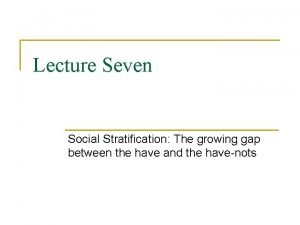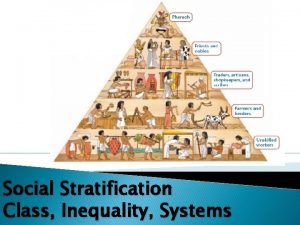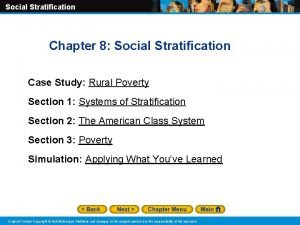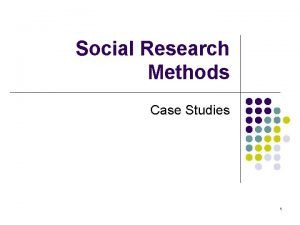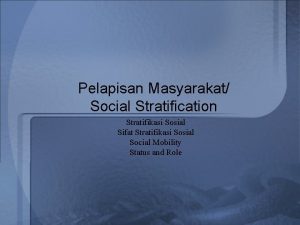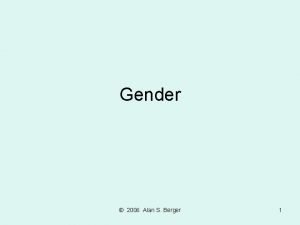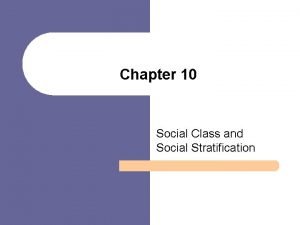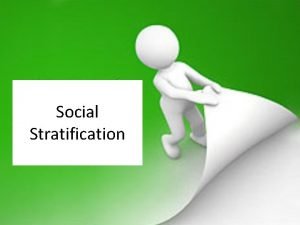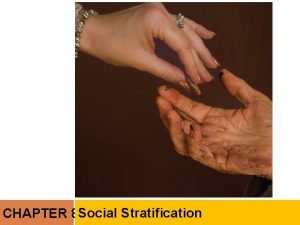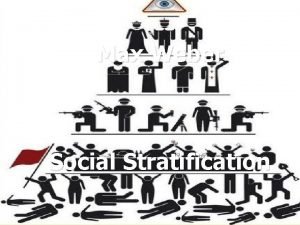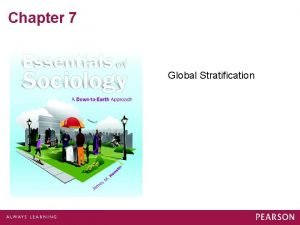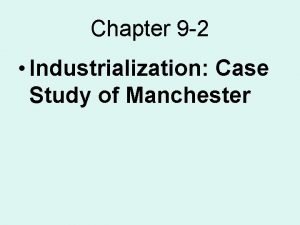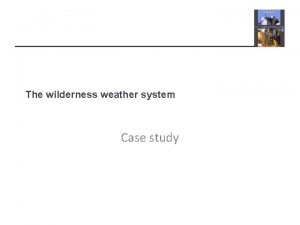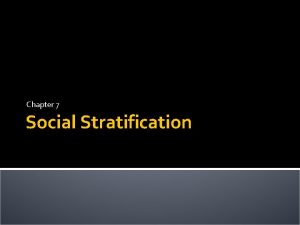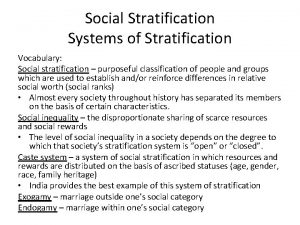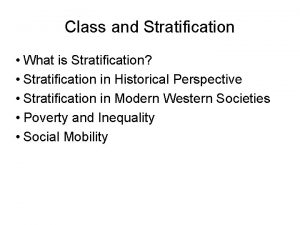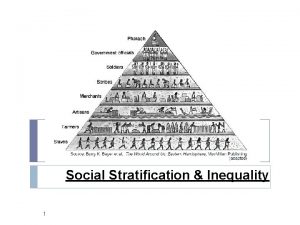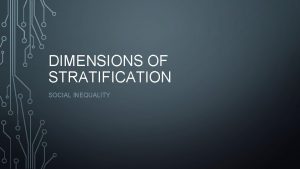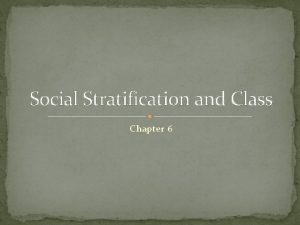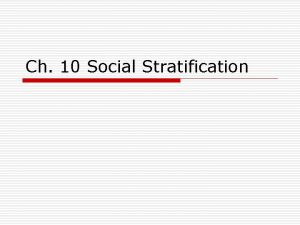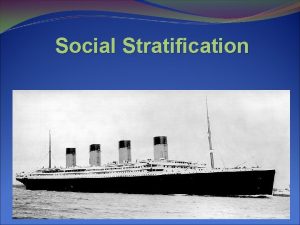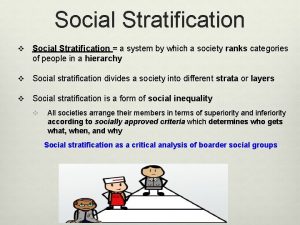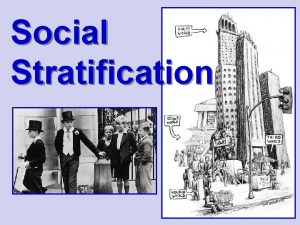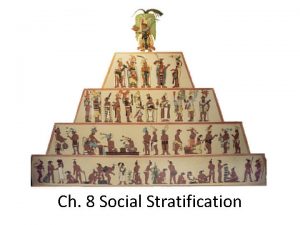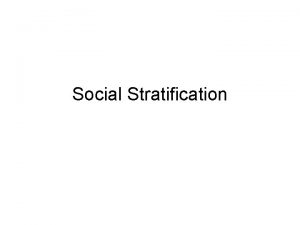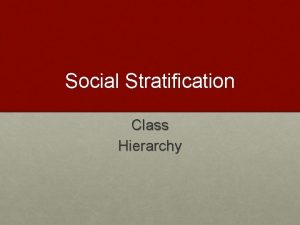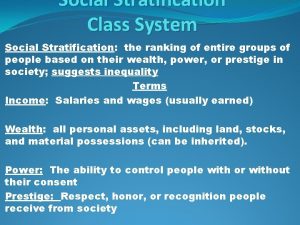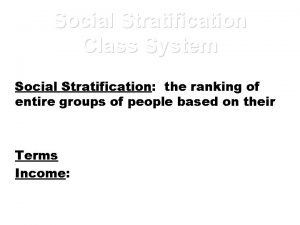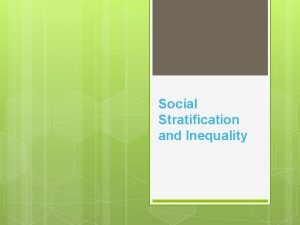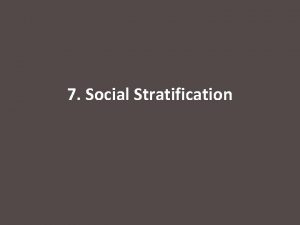Social Stratification Chapter 8 Social Stratification Case Study






















































- Slides: 54

Social Stratification Chapter 8: Social Stratification Case Study: Rural Poverty Section 1: Systems of Stratification Section 2: The American Class System Section 3: Poverty Simulation: Applying What You’ve Learned Original Content Copyright © Holt Mc. Dougal. Additions and changes to the original content are the responsibility of the instructor.

Social Stratification Case Study: Rural Poverty Most Americans equate poverty with images of the urban poor, but 20 percent of poor Americans live in rural areas. Poverty rates are much higher among rural minorities than among rural whites. Most of the rural poor have little access to government services, and the shift to a service economy has hit them especially hard. Both types of poverty are examples of how people around the world are affected by the unequal distribution of a society’s resources and rewards. Original Content Copyright © Holt Mc. Dougal. Additions and changes to the original content are the responsibility of the instructor.

Social Stratification Original Content Copyright © Holt Mc. Dougal. Additions and changes to the original content are the responsibility of the instructor.

Social Stratification Section 1 at a Glance Systems of Stratification • Most societies divide their members into ranks based on selected characteristics, which can lead to social inequality. • Two basic types of stratification systems exist today: caste systems and class systems. • Systems of stratification range from closed, in which movement between ranks is difficult, to open, in which individuals are able to move between ranks. Original Content Copyright © Holt Mc. Dougal. Additions and changes to the original content are the responsibility of the instructor.

Social Stratification Section 1 at a Glance (cont. ) Systems of Stratification • Members of a social class have similar levels of wealth, power, and prestige. • Functionalists and conflict theorists offer differing explanations of the causes and consequences of stratification, while other sociologists attempt to blend the two theoretical approaches. Original Content Copyright © Holt Mc. Dougal. Additions and changes to the original content are the responsibility of the instructor.

Social Stratification Systems of Stratification Main Idea • Many societies rank their members based on certain criteria, a process called social stratification. Reading Focus • What are the characteristics of the two types of stratification systems? • What are three dimensions of social stratification? • How do the major theories explaining social stratification differ? Original Content Copyright © Holt Mc. Dougal. Additions and changes to the original content are the responsibility of the instructor.

Social Stratification The Power of Popularity Do some groups at your school seem to have more power than others? Original Content Copyright © Holt Mc. Dougal. Additions and changes to the original content are the responsibility of the instructor.

Social Stratification Types of Stratification Systems Social stratification is the division of society into categories, ranks, or classes. These divisions lead to social inequality—the unequal sharing of resources and social rewards. Stratification systems lie on a continuum of open to closed systems according to how easy or difficult it is to change statuses. Both ascribed and achieved statuses can be used to determine social standing. Original Content Copyright © Holt Mc. Dougal. Additions and changes to the original content are the responsibility of the instructor.

Social Stratification Types of Stratification Systems Caste Systems • Closed stratification system • Resources and social rewards distributed based on ascribed statuses • Lifelong status determined by that of parents • Prohibits exogamy, or marriage outside of caste; promotes endogamy, or marriage within caste • Caste system in India has been challenged but still plays a major role Original Content Copyright © Holt Mc. Dougal. Additions and changes to the original content are the responsibility of the instructor.

Social Stratification Original Content Copyright © Holt Mc. Dougal. Additions and changes to the original content are the responsibility of the instructor.

Social Stratification Class Systems • Class system more open than closed stratification system • Resources and rewards distributed according to achieved statuses • Some control over place in society • Marx divided society into: – Bourgeoisie, or the owners of the means of production – Proletariat, or workers who sell their labor in exchange for wages • Weber described three factors of class: – Property – Prestige – Power Original Content Copyright © Holt Mc. Dougal. Additions and changes to the original content are the responsibility of the instructor.

Social Stratification Reading Check Contrast Describe the continuum of open and closed stratification systems. Answer: closed caste systems at extreme of continuum with no social mobility, class systems closer to other end of continuum depending on how much mobility they offer Original Content Copyright © Holt Mc. Dougal. Additions and changes to the original content are the responsibility of the instructor.

Social Stratification The Dimensions of Social Stratification Social class is a grouping of people with similar levels of wealth, power, and prestige. • Wealth – Wealth equals assets—value of everything the person owns— and income—money earned through salaries, investment returns, or other capital gains – In the United States, 1 percent of population controls one-third of wealth Original Content Copyright © Holt Mc. Dougal. Additions and changes to the original content are the responsibility of the instructor.

Social Stratification • Power – Power is the ability to control the behavior of others, with or without their consent – Can be based on force, a special skill or type of knowledge, particular social status, personal characteristics, or custom and tradition • Prestige – Prestige is the respect, honor, recognition, or courtesy an individual receives – Occupation, education, family background, and area of residence are common factors in the United States. • Socioeconomic status is a rating that combines social factors such as educational level, occupational prestige, and place of residence with the economic factor of income. Original Content Copyright © Holt Mc. Dougal. Additions and changes to the original content are the responsibility of the instructor.

Social Stratification Click on the image to play the Interactive. Original Content Copyright © Holt Mc. Dougal. Additions and changes to the original content are the responsibility of the instructor.

Social Stratification Reading Check Summarize How do wealth, power, and prestige affect social rankings? Answer: Sociologists use these social factors to calculate people’s socioeconomic status or social ranking. Generally, the higher one’s socioeconomic status, the higher one’s social ranking. Original Content Copyright © Holt Mc. Dougal. Additions and changes to the original content are the responsibility of the instructor.

Social Stratification Original Content Copyright © Holt Mc. Dougal. Additions and changes to the original content are the responsibility of the instructor.

Social Stratification Explaining Stratification • Functionalist Theory: sees stratification as necessary feature • Certain roles must be performed for stability of society • Without varying rewards some jobs would go unfilled • Critics point out that not everyone has same access to resources Original Content Copyright © Holt Mc. Dougal. Additions and changes to the original content are the responsibility of the instructor.

Social Stratification • Conflict Theory: see competition over scarce resources as the cause • Stratification comes from class exploitation • A group in power can shape policy to maintain its power • Critics point out that not everyone is suited for every position • Efforts at Synthesis • Dahrendorf suggests each approach might be used to explain specific aspects of stratification • Lenski suggests each approach might be used to describe different societies Original Content Copyright © Holt Mc. Dougal. Additions and changes to the original content are the responsibility of the instructor.

Social Stratification Reading Check Find the Main Idea How have sociologists synthesized the functionalist and conflict approaches to social stratification? Answer: Dahrendorf—each theory explains specific aspects of stratification. Lenski— functionalist theory applies to simple societies, conflict theory applies to more complex societies Original Content Copyright © Holt Mc. Dougal. Additions and changes to the original content are the responsibility of the instructor.

Social Stratification Cultural Diversity and Sociology Social Stratification Around the World All societies have ways to group their members based on specific characteristics. Ascribed statuses such as race, gender, and age are the most commonly used. • Kiwai Papuans: a simple society where everyone lived in similar dwellings and did the same work, but some men “a little more high” and women “down a little bit” • Maasai: nomadic group, stratified by age-sets • South Africa: racial stratification, officially ended in 1994 but still affects life • Mosuo: matriarchal and matrilineal, females are leaders • Democratic Republic of the Congo: stratified by gender, women don’t have same legal rights Original Content Copyright © Holt Mc. Dougal. Additions and changes to the original content are the responsibility of the instructor.

Social Stratification Original Content Copyright © Holt Mc. Dougal. Additions and changes to the original content are the responsibility of the instructor.

Social Stratification Thinking Critically • How do these systems of stratification lead to social inequality? • Do you think that societies around the world should allow social stratification to continue? Explain your answer. Original Content Copyright © Holt Mc. Dougal. Additions and changes to the original content are the responsibility of the instructor.

Social Stratification Section 2 at a Glance The American Class System • Sociologists use three techniques to determine social class: the reputational method, the subjective method, and the objective method. • Most sociologists use a system that identifies six social classes in the United States: the upper class, the upper middle class, the lower middle class, the working poor, and the underclass. • Because the United States has an open class system, social mobility—movement between social classes—is possible. • Sociologists are more interested in the structural causes of social mobility than in the individual causes. Original Content Copyright © Holt Mc. Dougal. Additions and changes to the original content are the responsibility of the instructor.

Social Stratification The American Class System Main Idea Most sociologists use six class divisions when describing the American class system. Because it is an open system, people are able to move between classes. Reading Focus • How do sociologists determine social class? • What are the characteristics of social classes in the United States? • What are the types of social mobility? Original Content Copyright © Holt Mc. Dougal. Additions and changes to the original content are the responsibility of the instructor.

Social Stratification Does everyone have access to the nation's best universities? Original Content Copyright © Holt Mc. Dougal. Additions and changes to the original content are the responsibility of the instructor.

Social Stratification Determining Social Class • The fewer ascribed statuses used to determine class, the more open the class system. • The United States has a fairly open system, but the rate of social mobility is not equal for every segment. • Three techniques are used to rank individuals. Original Content Copyright © Holt Mc. Dougal. Additions and changes to the original content are the responsibility of the instructor.

Social Stratification Reputational Method – Individuals in the community are asked to rank other members based on what they know of their characters and lifestyles – Suitable only for small communities – Cannot be used across communities Subjective Method – Individuals are asked to determine their own social rank – Most people choose middle class Objective Method – Income, occupation, and education – Statistical nature makes this method least biased – Choosing different factors brings different results Original Content Copyright © Holt Mc. Dougal. Additions and changes to the original content are the responsibility of the instructor.

Social Stratification Reading Check Find the Main Idea Explain the three techniques that sociologists use to determine social class. Answer: reputational—individuals in a community rank other community members based on what they know of their characters and lifestyles; subjective—individuals asked to determine their own social rank; objective— statistical method to determine social class by income, occupation, and education Original Content Copyright © Holt Mc. Dougal. Additions and changes to the original content are the responsibility of the instructor.

Social Stratification Social Classes in the United States • The Upper Class: 1 percent of population • “Old money” have been rich for generations • “New money” is not as prestigious • The Upper Middle Class: 14 percent of population • High-income businesspeople and professionals such as doctors and lawyers • Many are politically and socially active • The Lower Middle Class: 30 percent of population • Most hold white-collar jobs that require less education and provide less income such as nursing, middle management, sales • Live a comfortable life but must work to maintain it Original Content Copyright © Holt Mc. Dougal. Additions and changes to the original content are the responsibility of the instructor.

Social Stratification • The Working Class: 30 percent of population • Many hold jobs that require manual labor or blue-collar jobs • Jobs may pay more, but have less prestige than white-collar • Unexpected crises can push individuals into lower classes • The Working Poor: 22 percent of population • Lowest-paying jobs such as housecleaning, migrant farm work, and day labor • Many rely on government programs and are high school dropouts • The Underclass: 3 percent of population • Have experienced unemployment and poverty for several generations • Most rely on government programs • Life is a day-to-day struggle Original Content Copyright © Holt Mc. Dougal. Additions and changes to the original content are the responsibility of the instructor.

Social Stratification Original Content Copyright © Holt Mc. Dougal. Additions and changes to the original content are the responsibility of the instructor.

Social Stratification Original Content Copyright © Holt Mc. Dougal. Additions and changes to the original content are the responsibility of the instructor.

Social Stratification Reading Check Analyze How do American social classes reflect social inequality? Answer: Wealthier Americans have more and greater opportunities for education and jobs. Original Content Copyright © Holt Mc. Dougal. Additions and changes to the original content are the responsibility of the instructor.

Social Stratification Social Mobility • Social mobility is the movement between or within social classes. • Horizontal mobility refers to movement within a social class or stratum. • Vertical mobility refers to the movement between social classes or strata. • There are two kinds of vertical mobility: • intragenerational mobility (within a person’s lifetime) • intergenerational mobility (several generations of one family) Original Content Copyright © Holt Mc. Dougal. Additions and changes to the original content are the responsibility of the instructor.

Social Stratification Social Mobility Causes of Upward Mobility Causes of Downward Mobility • Individual effort • Technological change • Personal factors such as illness, divorce, or retirement • Change in merchandising patterns • Technological change altering the demand for labor • Increase in population’s general educational level • Overall economic health Original Content Copyright © Holt Mc. Dougal. Additions and changes to the original content are the responsibility of the instructor.

Social Stratification Reading Check Contrast What are the two types of vertical mobility and how do they differ? Answer: Intragenerational—changes in social position during one person’s life; intergenerational —status differences between generations in the same family Original Content Copyright © Holt Mc. Dougal. Additions and changes to the original content are the responsibility of the instructor.

Social Stratification Section 3 at a Glance Poverty • About 37 million Americans live in poverty, or below what society considers to be the minimum adequate standard of living. • The government calculates the poverty level annually based on the cost of an adequate diet. • Characteristics such as age, sex, and race affect poverty. • Poor and wealthy members of society have different life changes and behavior patterns. • Government welfare programs attempt to reduce inequality. Original Content Copyright © Holt Mc. Dougal. Additions and changes to the original content are the responsibility of the instructor.

Social Stratification Poverty Main Idea Americans living below the poverty level have fewer opportunities. Government welfare programs attempt to remedy this situation. Reading Focus • How is poverty defined in the United States? • What groups of Americans are affected by poverty? • What are the effects of poverty on poor Americans? • What steps have been taken by the federal government to reduce the effects of poverty? Original Content Copyright © Holt Mc. Dougal. Additions and changes to the original content are the responsibility of the instructor.

Social Stratification Can you imagine having to struggle for a one-cent raise? Original Content Copyright © Holt Mc. Dougal. Additions and changes to the original content are the responsibility of the instructor.

Social Stratification Defining Poverty in the United States • Although the United States is one of the richest countries in the world, about 13 percent of its population lives below the poverty line. • Poverty is a standard of living that is below the minimum level considered adequate by society. What one society sees as poverty might be seen as adequate by another society. • Poverty level is the minimum income needed by a family to survive, calculated as the cost of an adequate diet. • Criticism of the method of calculating poverty has led to attempts to find a better definition of poverty. Original Content Copyright © Holt Mc. Dougal. Additions and changes to the original content are the responsibility of the instructor.

Social Stratification Original Content Copyright © Holt Mc. Dougal. Additions and changes to the original content are the responsibility of the instructor.

Social Stratification Reading Check Identify Supporting Details How is the poverty level determined? Answer: calculate cost of an adequate diet, multiply by three Original Content Copyright © Holt Mc. Dougal. Additions and changes to the original content are the responsibility of the instructor.

Social Stratification Original Content Copyright © Holt Mc. Dougal. Additions and changes to the original content are the responsibility of the instructor.

Social Stratification Variations in American Poverty Not every American runs the same risk of being poor. Characteristics such as age, sex, and race and ethnicity affect poverty. • Age – As an age group, children have the largest percentage in poverty • Sex – About 57 percent of the poor are women • Race and Ethnicity – African Americans and Hispanics are more likely than whites to live in poverty Original Content Copyright © Holt Mc. Dougal. Additions and changes to the original content are the responsibility of the instructor.

Social Stratification Reading Check Infer What characteristics make it more likely that someone will live in poverty? Answer: being a child, a woman, an African American, or a Hispanic Original Content Copyright © Holt Mc. Dougal. Additions and changes to the original content are the responsibility of the instructor.

Social Stratification Effects of Poverty Poor and wealthy members of society have different life chances and behavior patterns. Life Chances Patterns of Behavior • Life chances define the likelihood that an individual will share in the opportunities and benefits of society. • Divorce rates are higher among low-income families. • Crime rates are higher in poor communities. • Life chances include health, length of life, housing, and education. • Poverty is a disadvantage in health and life expectancy. Original Content Copyright © Holt Mc. Dougal. Additions and changes to the original content are the responsibility of the instructor.

Social Stratification Reading Check Contrast How do the poor’s life chances differ from those of wealthy Americans? Answer: Poor Americans have fewer opportunities to share in the benefits of society. Original Content Copyright © Holt Mc. Dougal. Additions and changes to the original content are the responsibility of the instructor.

Social Stratification Government Responses to Poverty • In 1964 President Lyndon Johnson declared a “war on poverty, ” and the federal government has taken an active role in attempting to reduce inequality. • Almost 37 million Americans still live in poverty. • Increased Social Security benefits and Medicare have reduced poverty among the aged. • Transfer payments redistribute money within society by funneling a percentage of tax revenues to groups that need public assistance. • Subsidies transfer goods and services rather than cash. • In 1996 federal law turned some welfare over to the states. • Those who get off welfare face difficulty feeding their families. Original Content Copyright © Holt Mc. Dougal. Additions and changes to the original content are the responsibility of the instructor.

Social Stratification Original Content Copyright © Holt Mc. Dougal. Additions and changes to the original content are the responsibility of the instructor.

Social Stratification Reading Check Summarize Describe the two methods used by government welfare programs? Answer: transfer payments—percentage of tax revenues goes to groups that need public assistance, e. g. SSI and TANF; subsidies— transfer or subsidize goods and services, e. g. food stamps and Medicaid Original Content Copyright © Holt Mc. Dougal. Additions and changes to the original content are the responsibility of the instructor.

Social Stratification Simulation: Applying What You’ve Learned Only What You Can Afford What are the significant, everyday lifestyle differences between people of different classes in the United States? 1. Introduction 2. Creating Your Budget • In this simulation you will glimpse what some of the American social classes look like from within using three imaginary families. • Figure out how much money your family has for each month. • Decide what percentage of the family’s income should go toward housing, transportation, food, health care, personal care, and • Create a budget for each. miscellaneous items. • Chart the budget in a pie graph. Original Content Copyright © Holt Mc. Dougal. Additions and changes to the original content are the responsibility of the instructor.

Social Stratification Original Content Copyright © Holt Mc. Dougal. Additions and changes to the original content are the responsibility of the instructor.

Social Stratification Simulation (cont. ) 3. Discussion • What did you learn from this lab? As a group, discuss the following: • How did the options for each family differ? • Which families bought and which rented? • How did the amount of money for unnecessary expenses vary? • Did your families have any money for emergencies? • How might government programs change the Drake family budget? Original Content Copyright © Holt Mc. Dougal. Additions and changes to the original content are the responsibility of the instructor.
 Social stratification vs social inequality
Social stratification vs social inequality Stratification and inequality
Stratification and inequality Chapter 8 social stratification
Chapter 8 social stratification Chapter 9 social stratification
Chapter 9 social stratification Causes of social mobility
Causes of social mobility Best worst and average case
Best worst and average case Foxmeyer erp failure case study
Foxmeyer erp failure case study Verna and sam barriers
Verna and sam barriers Case study in social research
Case study in social research Ethics in mis
Ethics in mis Mixed social stratification
Mixed social stratification Gender social stratification
Gender social stratification Regular expression symbols
Regular expression symbols Social stratification systems
Social stratification systems Social stratification in sociology
Social stratification in sociology Dimensions of stratification
Dimensions of stratification Stratification weber
Stratification weber Max weber social class
Max weber social class Systems of social stratification
Systems of social stratification Definition social stratification
Definition social stratification Diagram stratifikasi sosial
Diagram stratifikasi sosial Mixed social stratification
Mixed social stratification Social stratification defintion
Social stratification defintion Global stratification systems
Global stratification systems Chapter 9 section 2 industrialization case study manchester
Chapter 9 section 2 industrialization case study manchester Case study method
Case study method Chapter 10 case study
Chapter 10 case study Case study chapter 4
Case study chapter 4 Difference between short case and long case
Difference between short case and long case Linear search big o notation
Linear search big o notation Glennan building cwru
Glennan building cwru Bubble sort algorithm pseudocode
Bubble sort algorithm pseudocode Bubble sort best case and worst case
Bubble sort best case and worst case Bubble sort best case and worst case
Bubble sort best case and worst case Ambiguous case triangles
Ambiguous case triangles Zara mis
Zara mis Yelp case study analysis
Yelp case study analysis K.f case study
K.f case study Whole foods case study
Whole foods case study Action research vs case study
Action research vs case study Volkswagen case study ppt
Volkswagen case study ppt Plant machinery valuation
Plant machinery valuation Phil stephens villanova
Phil stephens villanova Starbucks foreign direct investment
Starbucks foreign direct investment Case study 11
Case study 11 Uml case study
Uml case study Illustrative case study example
Illustrative case study example Tuna for lunch case study answer key
Tuna for lunch case study answer key Tuna for lunch case study
Tuna for lunch case study Rainforest case study
Rainforest case study Supermarket seo case study
Supermarket seo case study Threats to biodiversity a case study of hawaiian birds
Threats to biodiversity a case study of hawaiian birds Mount st helens case study
Mount st helens case study Therac-25 case study
Therac-25 case study Wilderness weather station
Wilderness weather station
